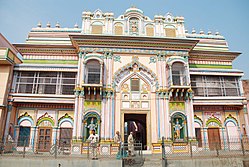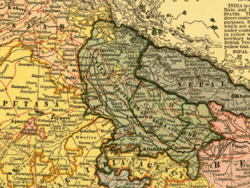Ayodhya
Ayodhya (Hindustani: [əˈjoːdʱːjaː] (![]() listen); IAST: Ayodhyā) is a city on the banks of holy river Saryu in the Indian state of Uttar Pradesh. It is the administrative headquarters of the Ayodhya district as well as the Ayodhya division of Uttar Pradesh, India. It shares a municipal corporation with its neighbouring twin city of Faizabad. The Ramayana tells that Raam, a god of Hindus, was born in Ayodhya. Ayodhya is on the bank of the Sarayu River. The city is about five kilometers east of Faizabad, another important city of Uttar Pradesh.
listen); IAST: Ayodhyā) is a city on the banks of holy river Saryu in the Indian state of Uttar Pradesh. It is the administrative headquarters of the Ayodhya district as well as the Ayodhya division of Uttar Pradesh, India. It shares a municipal corporation with its neighbouring twin city of Faizabad. The Ramayana tells that Raam, a god of Hindus, was born in Ayodhya. Ayodhya is on the bank of the Sarayu River. The city is about five kilometers east of Faizabad, another important city of Uttar Pradesh.
|
| |
|---|---|
City | |
|
Clockwise from the top: Ram ki Paidi Ghat, Ayodhya Ghaat on the Saryu river, Kanak Bhawan Temple, Vijayraghav Mandir in Ayodhya | |
| Coordinates: 26°48′N 82°12′E / 26.80°N 82.20°ECoordinates: 26°48′N 82°12′E / 26.80°N 82.20°E | |
| Country | |
| State | Uttar Pradesh |
| District | Ayodhya |
| Government | |
| • Type | Mayor–Council |
| • Body | Ayodhya Municipal Corporation |
| • Mayor | Rishikesh Upadhyay, BJP |
| Area | |
| • Total | 79.8 km2 (30.8 sq mi) |
| Elevation | 93 m (305 ft) |
| Population (2011[1]) | |
| • Total | 55,890 |
| • Density | 700.4/km2 (1,814.0/sq mi) |
| Language | |
| • Official | Hindi[2] |
| • Additional official | Urdu[2] |
| • Regional | Awadhi[3] |
| Time zone | UTC+05:30 (IST) |
| PIN | 224001 |
| Vehicle registration | UP-42 |
| Website | ayodhya.nic.in |
The Ramayana tells that Ayodhya was the capital city of Raam’s kingdom. Raam was a form (an avatar) of Vishnu. Ayodhya is one of the seven most holy cities of Hindus.
Today, Ayodhya is a popular destination for pilgrims and tourists who come to visit the Ram Janmabhoomi temple and other historical sites associated with Lord Rama. The city is also known for its rich cultural heritage and is home to several ancient temples, shrines, and other historical monuments. You can hire a car driver for outstation to explore the culture of lord Ram.[4]
Ayodhya Media
Terracotta image of Jain Tirthankar dated fourth century BCE excavated from Ayodhya
Gold carving depiction of the legendary Ayodhya at the Ajmer Jain temple
The Dhanadeva-Ayodhya inscription, first-century BC
Coin of ruler Muladeva, of the Deva dynasty minted in Ayodhya, Kosala. Obv: Muladevasa, elephant to left facing symbol. Rev: Wreath, above symbol, below snake.
Ayodhya in 1785 as seen from river Ghaghara; painting by William Hodges. It depicts the Svargadvar Ghat. A mosque of Aurangzeb period in the background.
United Provinces of Agra and Oudh, showing 'Ajodhia', 1903 map
Panoramic view of Ram ki Paidi ghat
Ram Mandir in Ayodhya is believed to be the birthplace of Rama
References
- ↑ "AYODHYA in Faizabad (Uttar Pradesh)". .citypopulation.de. Retrieved 1 August 2020.
- ↑ 2.0 2.1 "52nd Report of the Commissioner for Linguistic Minorities in India" (PDF). nclm.nic.in. Ministry of Minority Affairs. p. 49. Archived from the original (PDF) on 25 May 2017. Retrieved 12 February 2019.
- ↑ "Awadhi". Ethnologue. Retrieved 7 May 2019.
- ↑ "Plan Your Best Trip to Ayodhya- Hire a Car Driver for Outstation Travel from Gurgaon - Carchalak". 2023-03-25. Retrieved 2023-04-04.











